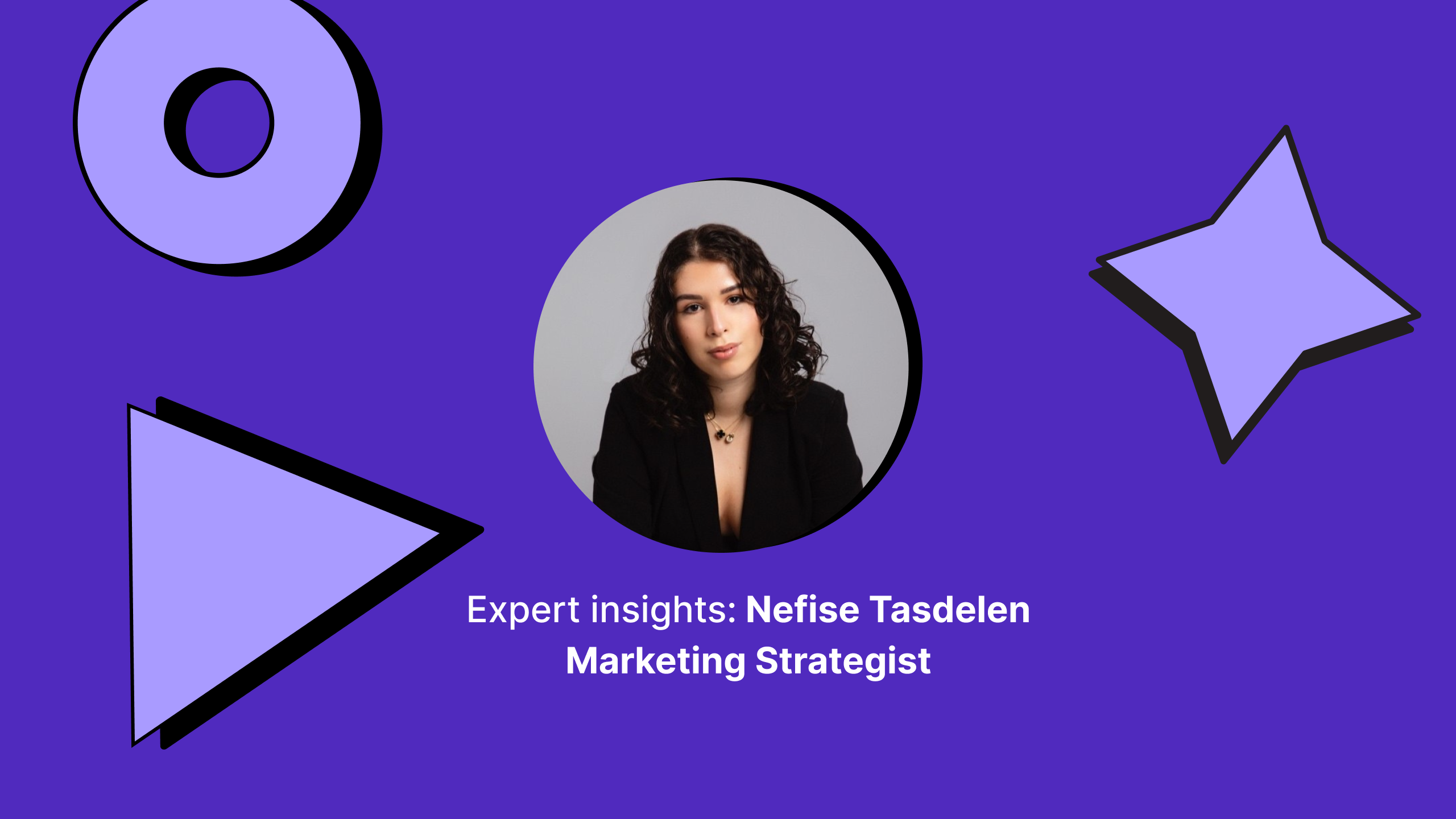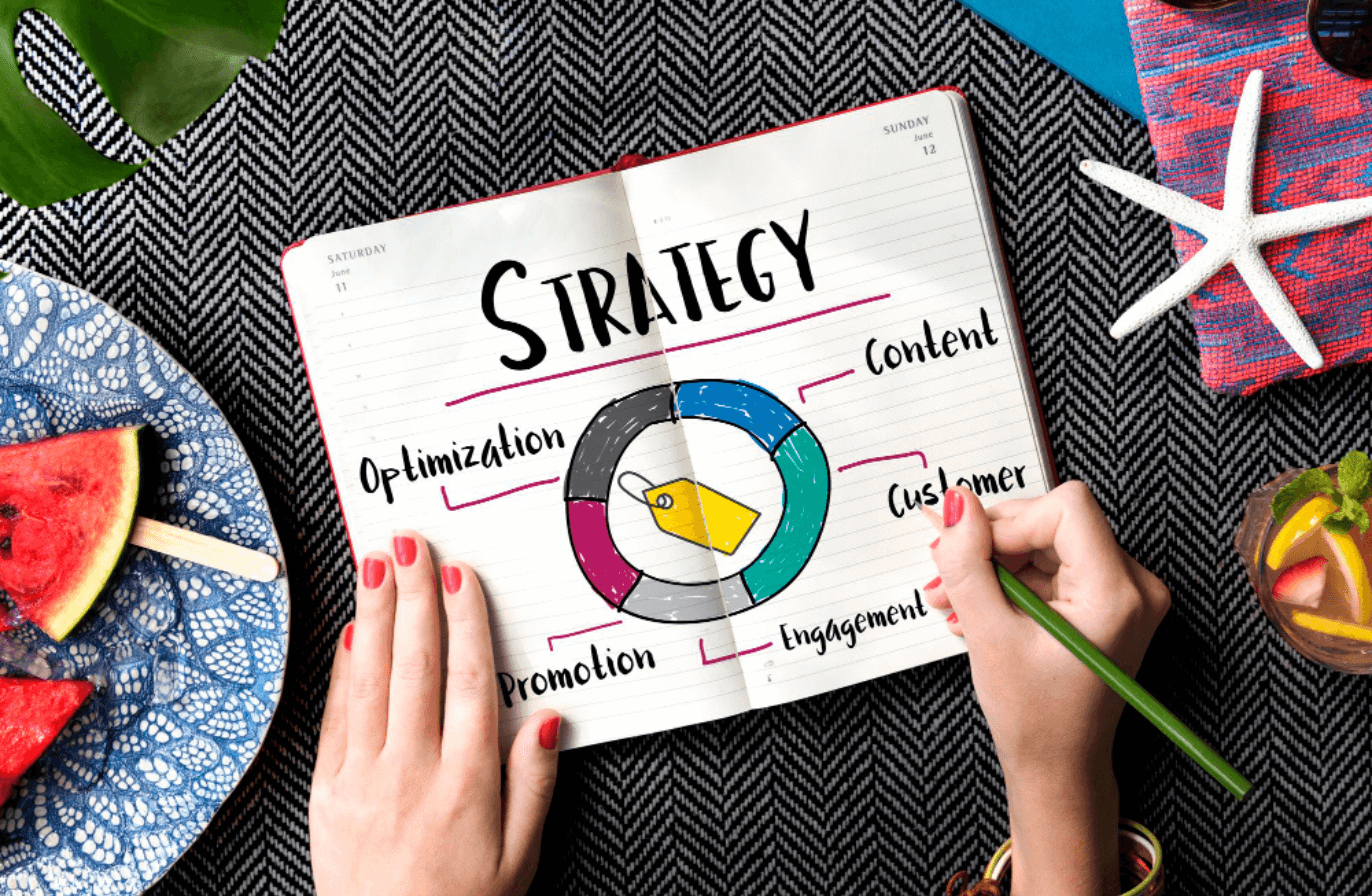How to Build a Social Media Content Strategy: 12 Steps and Tips Included
Want to grow your online presence? Learn how to create a winning social media content strategy that connects with your audience.

A killer social media content strategy is the backbone of every successful brand in the digital age. It's not just about showing up online; it's about having a purposeful social media strategy that connects with your audience, sparks engagement, and drives results.
From scroll-stopping videos and bold infographics to authentic stories and shareable memes, the right types of social media content can set your brand apart in an overcrowded feed.
But knowing how to create content on social media that truly resonates takes more than guesswork. It's about blending creativity with data, understanding your audience’s needs, and delivering value through every post.
So, without further ado, let's get into the nitty-gritty of creating a social media content strategy.
Key takeaways of this article:
- What is a social media content strategy and what are the steps that need to be covered to generate social media success.
- From strategical steps such as establishing goals and selecting diferent platform over others to more executional ones such as creating content and running a competitive analysis, every important aspect is listed below.
What is a social media content strategy?
A social media content strategy is a tailored plan for creating, curating, and publishing content on social media platforms to achieve specific goals, such as boosting engagement, driving traffic, or building brand awareness.
Unlike a broader social media strategy, which focuses on overarching objectives and platform choices, having a content plan for social media focuses on the content itself—what to post, when, and why.
How to create a content strategy for social media?
A killer mix of storytelling, visuals, and trends can transform your social presence into a powerhouse of engagement. Add data-driven social media growth strategies implementation, and you're set for making your brand stand out in a noisy digital world.
From defining your objectives and understanding your audience to choosing the right platforms and crafting engaging content, we'll cover everything you need to know to get started when building a content strategy.
Ready to take the guesswork out of your social media game?
Step 1: Set traceable content goals
An effective content strategy starts with clear and traceable social media goals. They act as your compass, steering every decision you make—from what content to create to how you measure success. For that, the SMART methodology is a must.
Vague goals like "increase engagement" won't cut it. Instead, the SMART framework ensures your objectives are precise and actionable.
Here's how to apply it:
- Specific: Define exactly what you want to achieve. For example, replace “improve engagement” with “boost Instagram engagement rate by 10%.”
- Measurable: Attach metrics to your goals so it's easier to track progress. For instance, count comments, shares, or click-through rates.
- Achievable: Set realistic benchmarks based on past performance. If your LinkedIn posts average 200 impressions, aiming for 1,000 impressions in three months is reasonable.
- Relevant: Tie your social goals to your broader business priorities. For instance, if your focus is sales, concentrate on driving traffic to your e-commerce site through social media.
- Time-bound: Assign a deadline. Instead of leaving it open-ended, say, “Gain 15% more TikTok followers within 90 days.”
Here's what well-thought-out goals look like:
- Increase LinkedIn impressions by 20% in Q1 to grow visibility in the B2B space.
- Generate 500 clicks to your website from Instagram Stories within 60 days to boost conversions.
- Hit a 5% engagement rate on Facebook posts by the month's end with a mix of videos and carousels.
Starting with solid SMART goals ensures your social strategy isn't just busy work but a results-driven effort. Goals help you stay focused, make smarter decisions, and track progress with confidence.
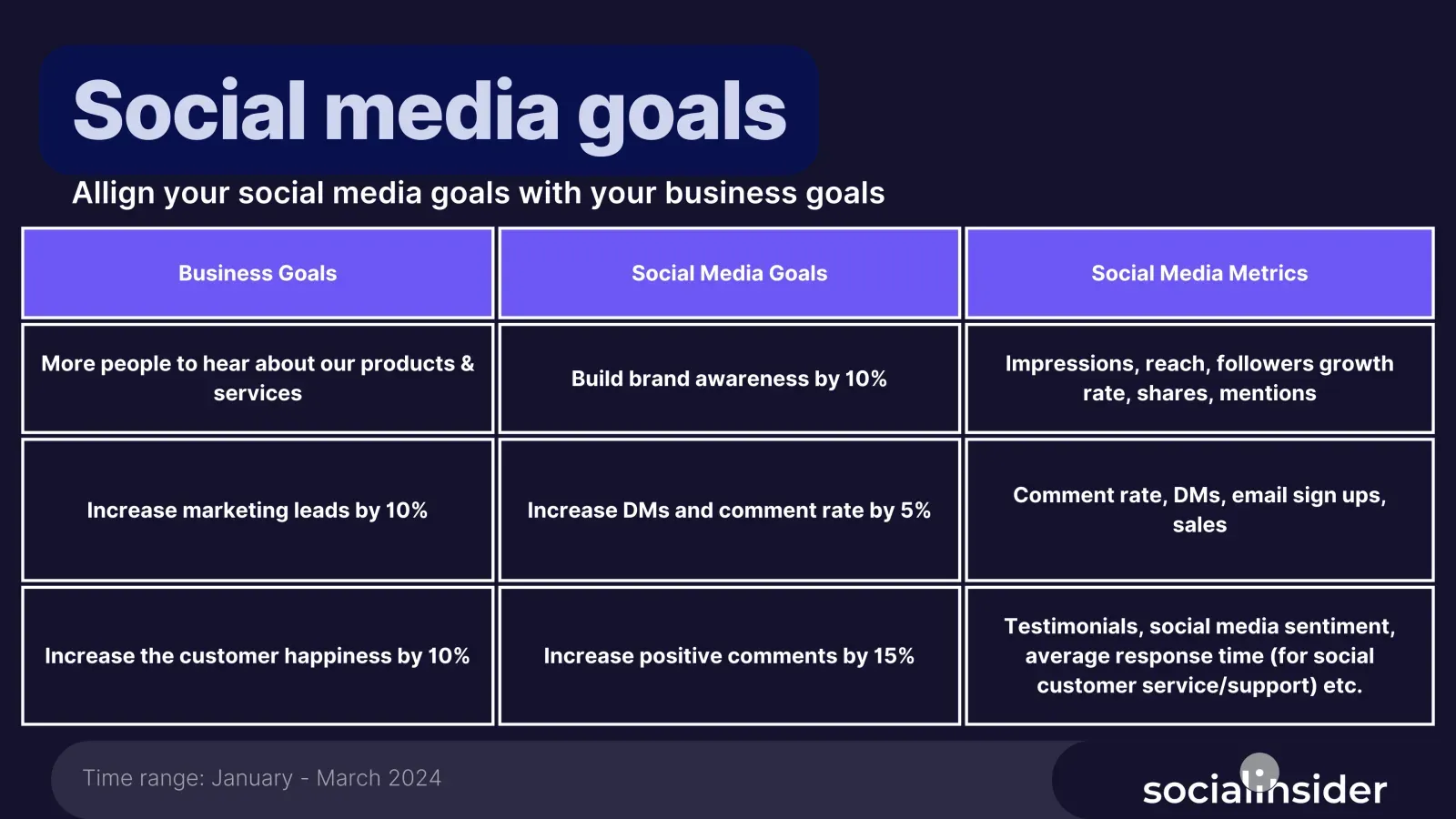
Setting the right goals is crucial for measuring success. Speaking of measuring performance, Socialinsider's analytics dashboard allows you to track all essential metrics in one place, so you can determine your progress over time at a glance.
Moreover, you can benchmark your performance against industry peers and competitors to get a better idea of where you're standing and what you could improve. For example, one of our clients in the tech industry used our competitive benchmarking tools to identify how their competitors were growing and managed to grow their account from 0 to 1700+ followers in less than a year.
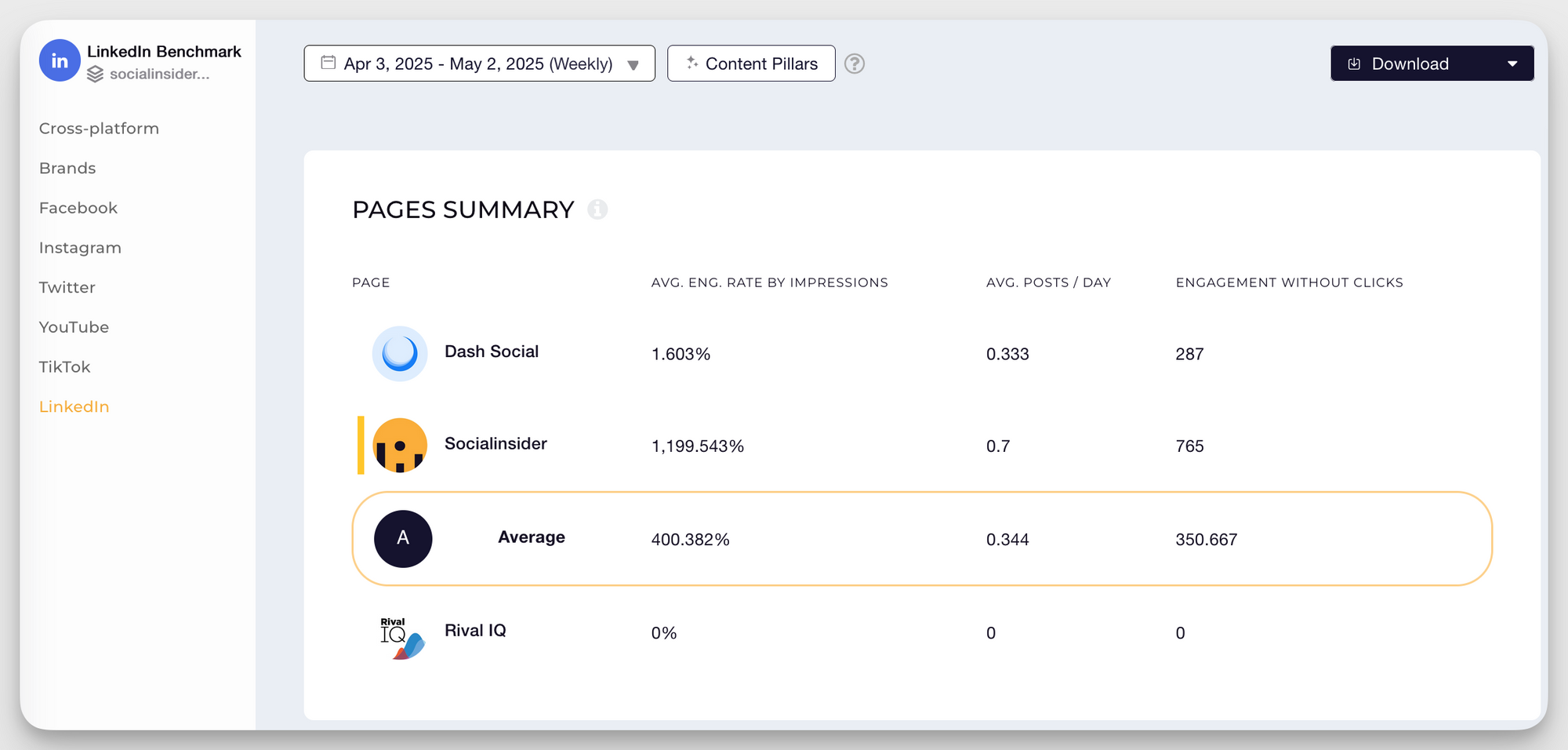
Step 2: Understand your audience
Content planning for social media isn't about guessing—it's about knowing who your audience is, what they care about, and how they interact online so your content feels like it's made just for them.
Without this foundation, even your most brilliant posts can miss the mark.
Here's what to do.
Establish audience demographics
Start with the essential demographic information. This includes:
Age: Different age groups have distinct content preferences:
- Gen Z (13–19): They're all about bite-sized, engaging content—think: TikTok trends and Instagram Reels.
- Millennials (20–35): They love a mix of informative, relatable, and visually appealing content, especially on Instagram, X, and LinkedIn.
- Gen X and Boomers (35+): Practical and detailed content performs best here, particularly on Facebook and LinkedIn.
Gender: Tailor your tone, visuals, and messaging.
For instance: a female-focused audience might respond to empowering themes and vibrant imagery. Whereas mixed-gender audiences require balance—neutral tones and inclusive visuals work well.
Location: Understanding where your audience lives allows you to:
- Post at times when they're most active online.
- Create localized content that feels personal.
- Adapt to cultural norms and preferences.
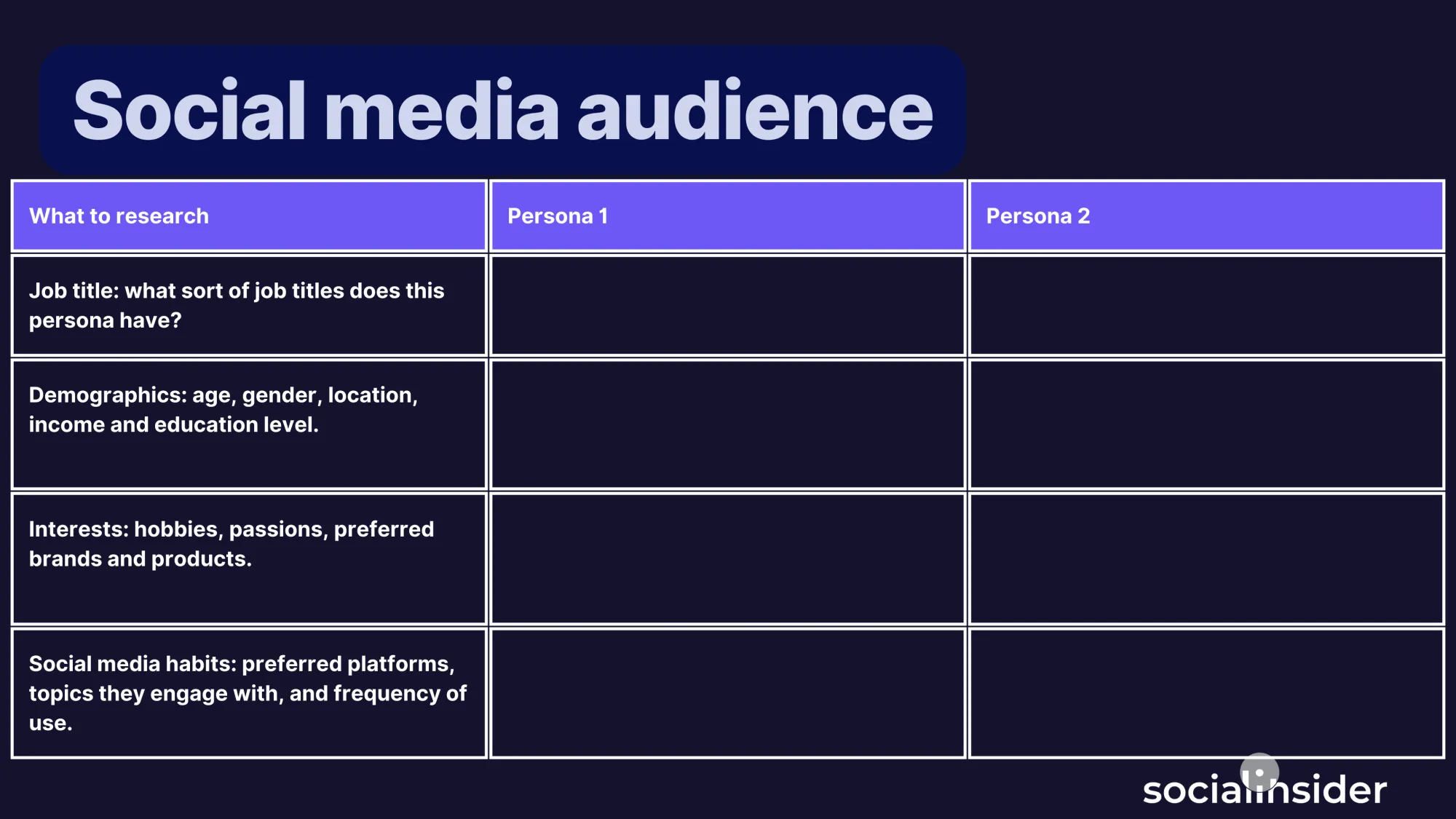
With Socialinsider, you can get information that is not available on native platforms. For example, for LinkedIn, you can learn more than your followers' location; you get insights into their job title, seniority, industry, and company size, which will help you better define your personas.
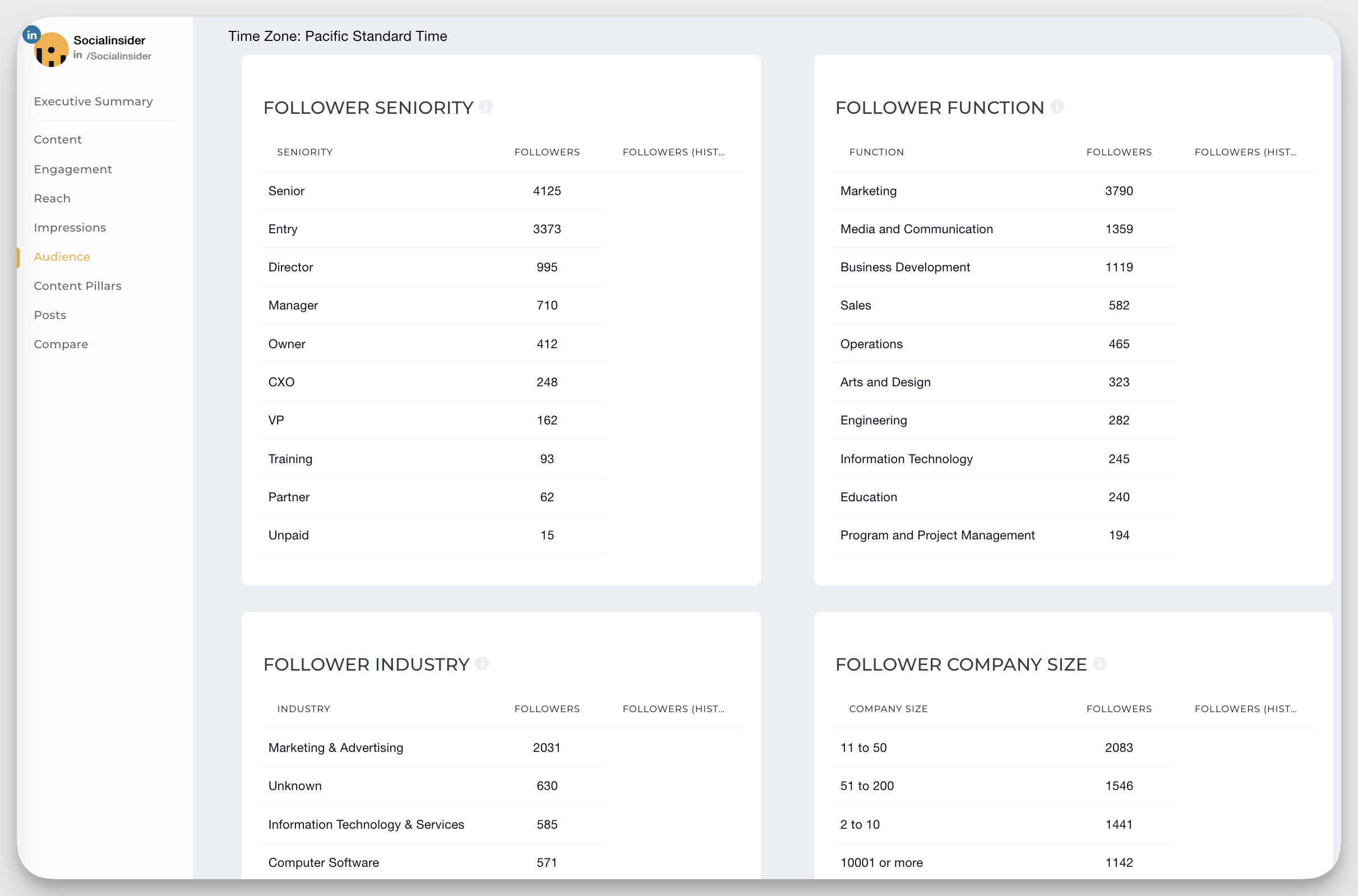
Identify pain points and behavioral patterns
Understanding pain points reveals the challenges, frustrations, or unmet needs your target customers face, allowing you to tailor your product, service, or messaging to solve their problems.
Behavioral pattern identification is equally important, as it showcases how your audience interacts with content, makes decisions, and navigates their buyer's journey.
For example, do they prefer scrolling through TikTok or Instagram?
Together, these analysis points help create strong buyer personas, which provide help in understanding how your messaging resonates with the audience on a personal level, increasing engagement and conversion rates.
Here, Socialinsider can help you identify the best-performing content types and content pillars by looking at your content (or your competitors') and seeing what works.
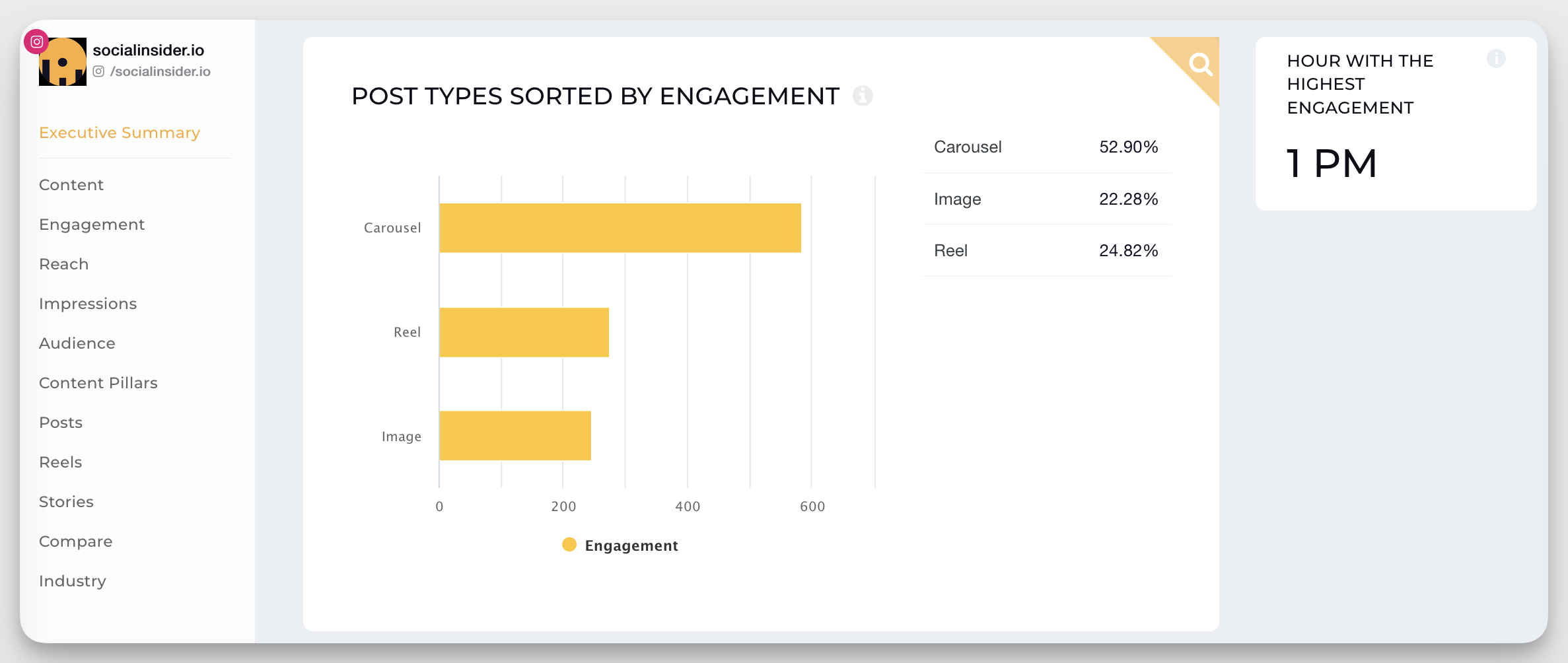
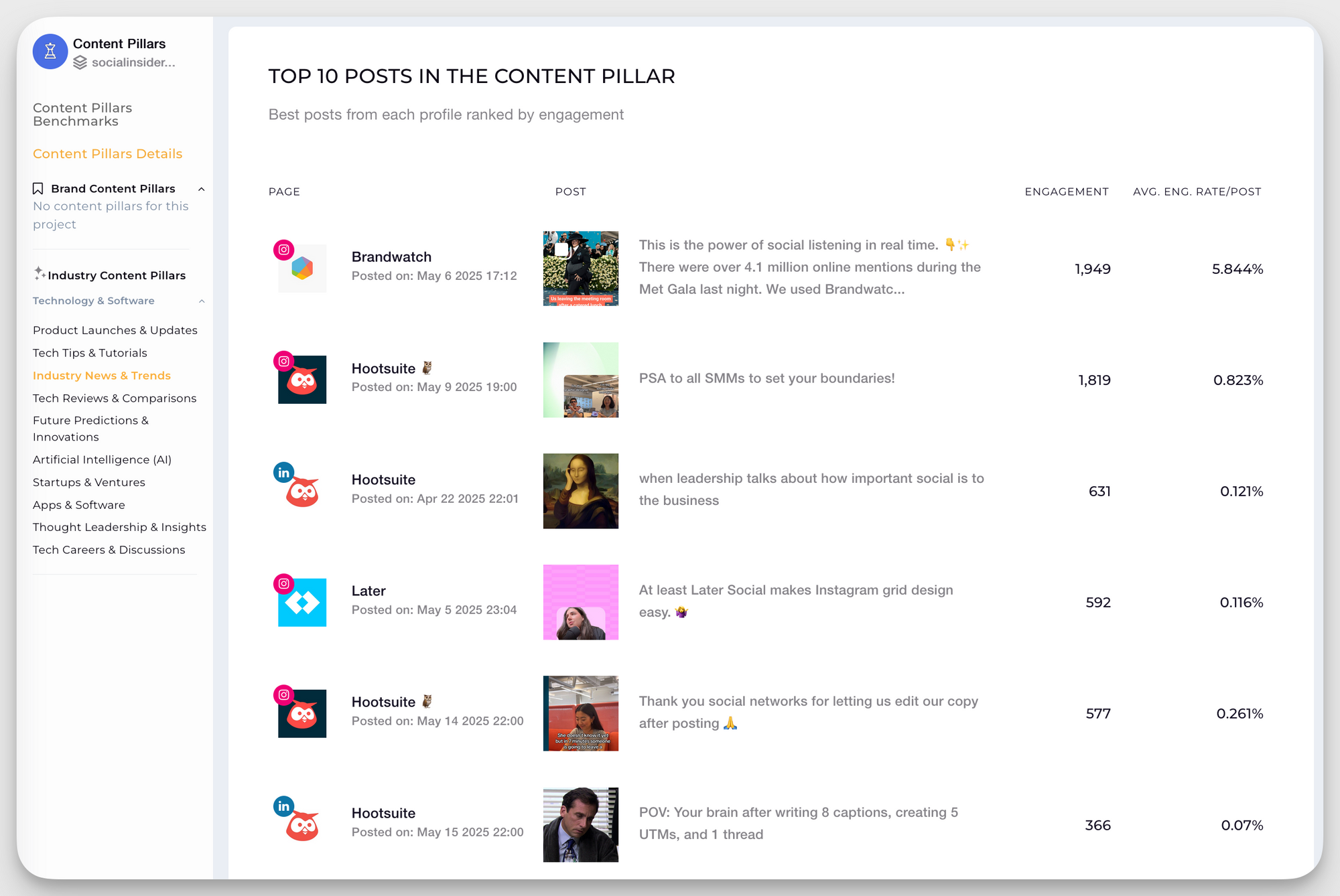
Collect social media audience insights
For this part, social media analytics tools are incredibly effective, helping you to identify your top-performing posts across platforms.
Such tools allow you to quickly identify your best-performing posts and easily understand what content resonates the most with them (videos, carousels, or single images), or when they are most active across different platforms.
Step 3: Prioritize platforms that best align with your objectives
Wondering how to plan content for social media? Firstly, understand that every social media platform serves a different purpose, and your success depends on choosing the right ones for your strategy.
Instead of spreading yourself thin, focus on planning content for platforms that resonate most with your goals and social media personas. When you prioritize the right platforms, you maximize your resources and deliver more meaningful content on social media.
Consequently, your social media efforts will feel intentional, not scattershot—and that’s where the magic happens.
Align platforms with objectives
Each social platform has unique characteristics that cater to specific content types and audiences. Prioritize the ones that best support your objectives.
For instance, Instagram is best for brand engagement with a strong emphasis on visual storytelling. You can use Reels and Stories to showcase products, run interactive polls, or host Q&A sessions.
On the other hand, Facebook is ideal for driving sales and community building, especially for older demographics. You can use Facebook Groups to foster brand loyalty and share promotional offers
TikTok is a completely different ballgame. It's more suited for building brand awareness among Gen Z and Millennials through engaging, trend-driven content like challenges and tutorials.
Match platforms with social media personas
Understand your audience's platform preferences to focus your efforts effectively:
- For Gen Z, prioritize TikTok and Instagram for playful, interactive content.
- For Millennials, use Instagram and LinkedIn for a mix of professional and personal content.
- For Gen X and Boomers, focus on Facebook and LinkedIn to provide practical, detailed information.
Whichever social media marketing channel you choose, focus your efforts on the platforms where your audience is most active and your objectives align. Remember, quality trumps quantity every time.
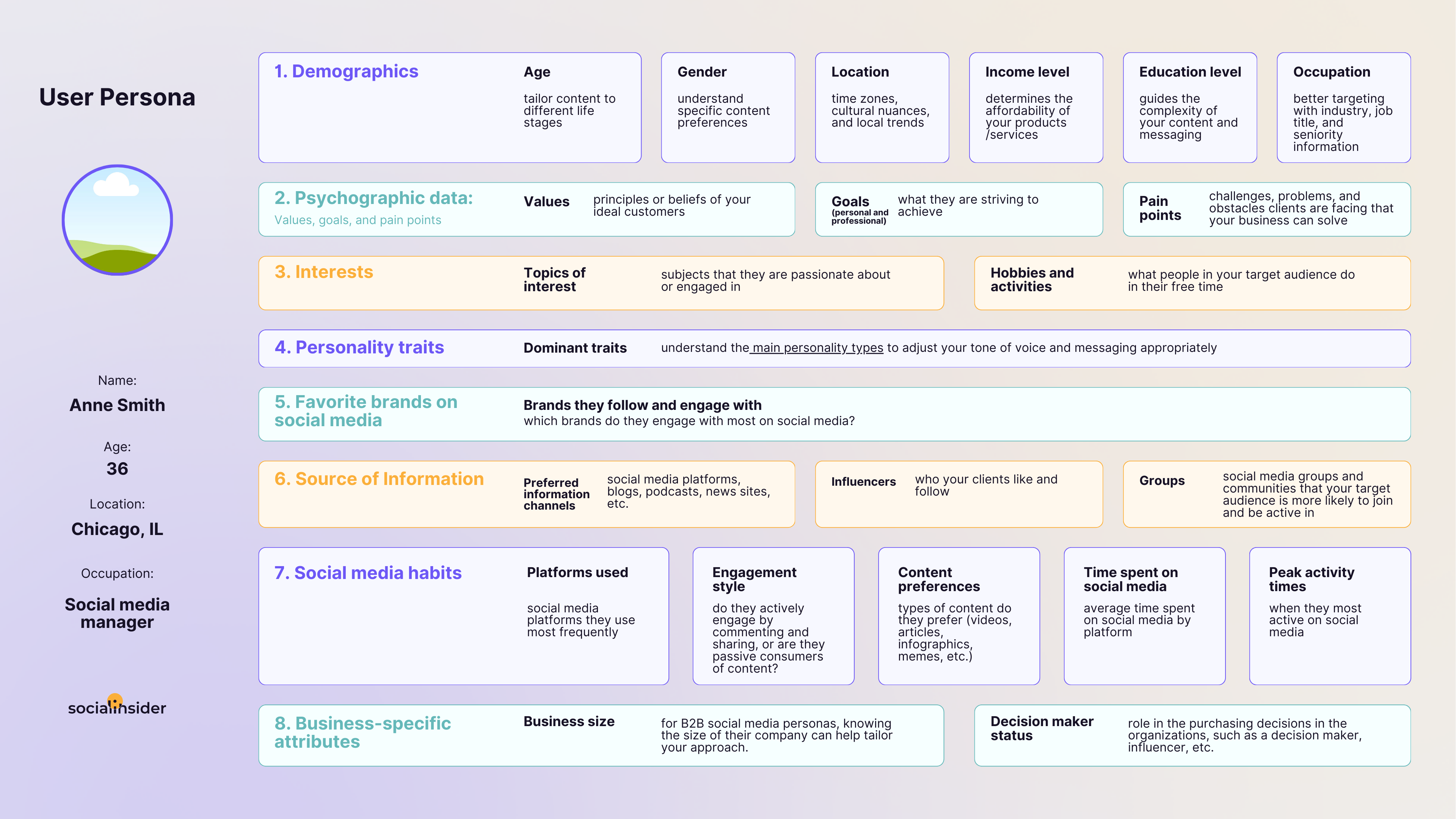
The 50/30/20 rule for platform investment
As not all platforms will yield equal results for your business, we recommend following the 50/30/20 rule for resource allocation:
- 50% of resources to your primary platform (where your audience is most active)
- 30% to your secondary platform (growing audience or strategic importance)
- 20% to experimental platforms (emerging channels or smaller audience segments)
This approach ensures you maintain focus on platforms with proven ROI while still exploring new opportunities.
Step 4: Perform a competitive analysis
If you want your social media content to make an impact, you need to know what you're up against. Competitive analysis and benchmarking give you an insider's look at audience preferences, trending content, and successful engagement tactics.
By studying your competitor's wins and missteps, you can replicate what works, sidestep common mistakes when posting content, and identify unique opportunities to stand out.
- Content types and performance: What types of posts do they use most frequently (e.g., videos, carousels, or images)? Are certain themes or campaigns (e.g., user-generated content or seasonal promotions) more successful?
- Engagement metrics: Look beyond likes—analyze comments and shares, to figure out which posts spark deeper interest and conversations or increased visibility.
- Posting frequency and timing: Review how often they post and identify patterns in timing that maximize engagement rates. Do certain days or times yield better engagement?
- Platform-specific performance: Compare how competitors perform across different platforms (Instagram, TikTok, LinkedIn) to identify their strengths and weaknesses.
Leveraging Socialinsider for competitive analysis
Socialinsider benchmarks performance across platforms and delivers actionable insights, simplifying competitive intelligence.
Take Uber and Lyft as an example in the following screenshot:
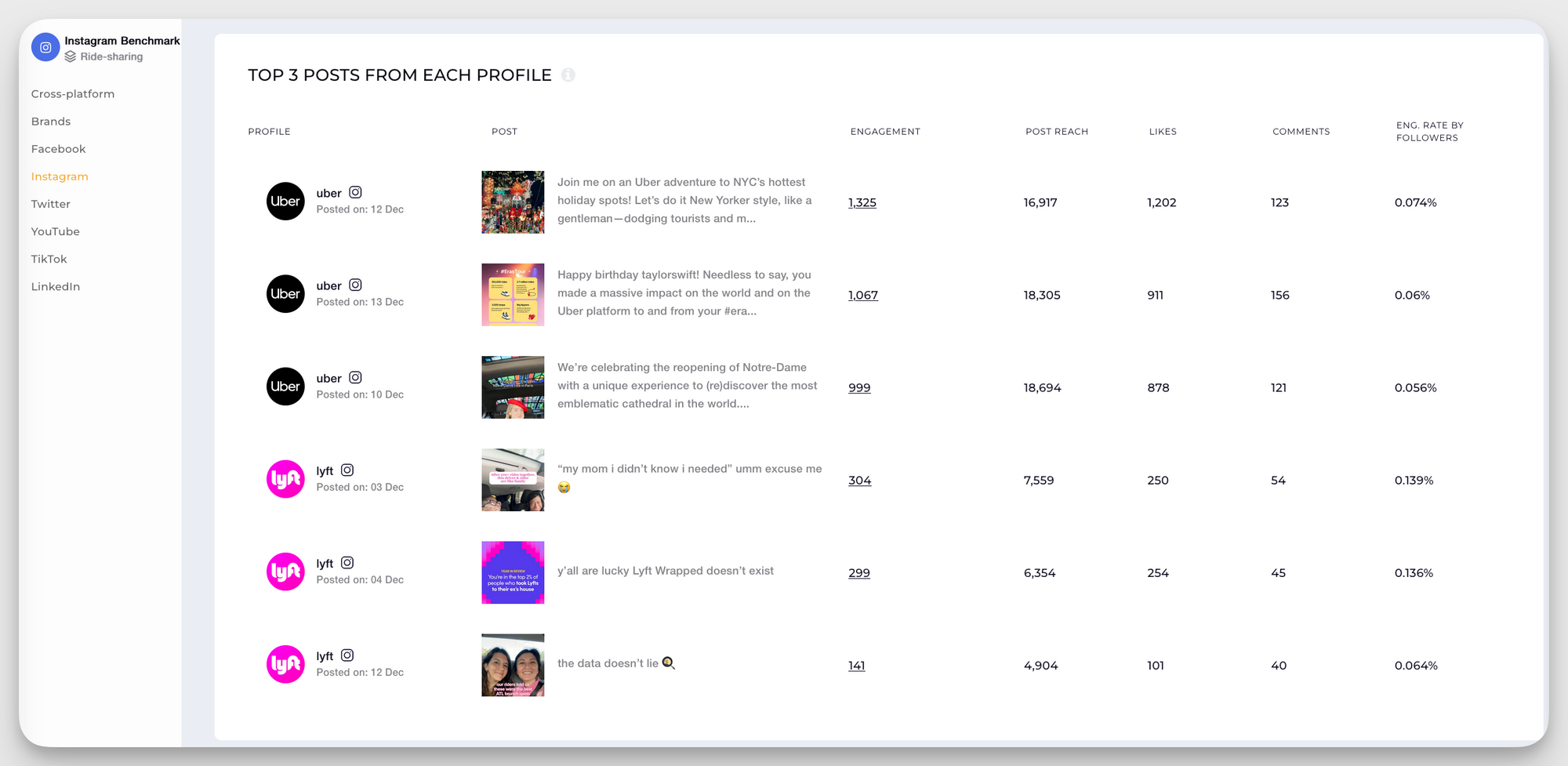
Socialinsider highlights Uber's NYC holiday post, which raked in the highest engagement, proving how effective localized, visually rich content can be.
It even reveals that Uber consistently outshines Lyft in Instagram engagement, pointing to strategies worth learning from, like emotional holiday campaigns such as "The Gift of Love."
Step 5: Research social media benchmarks and best practices
You need to know what success looks like, and social media benchmarks (industry averages, platform norms) offer a clear yardstick to help you determine where your performance stands. Social media metrics like engagement rates, reach, impressions, and click-through rates further help you compare your social media content plan with competitors.
You gain a solid foundation to assess what works and can refine your strategy accordingly.
For example, did you know that on Facebook, for instance, albums tend to generate the highest engagement? So, if you focus on creating more albums for product collections or events, you're on the right path to increasing your Facebook success.
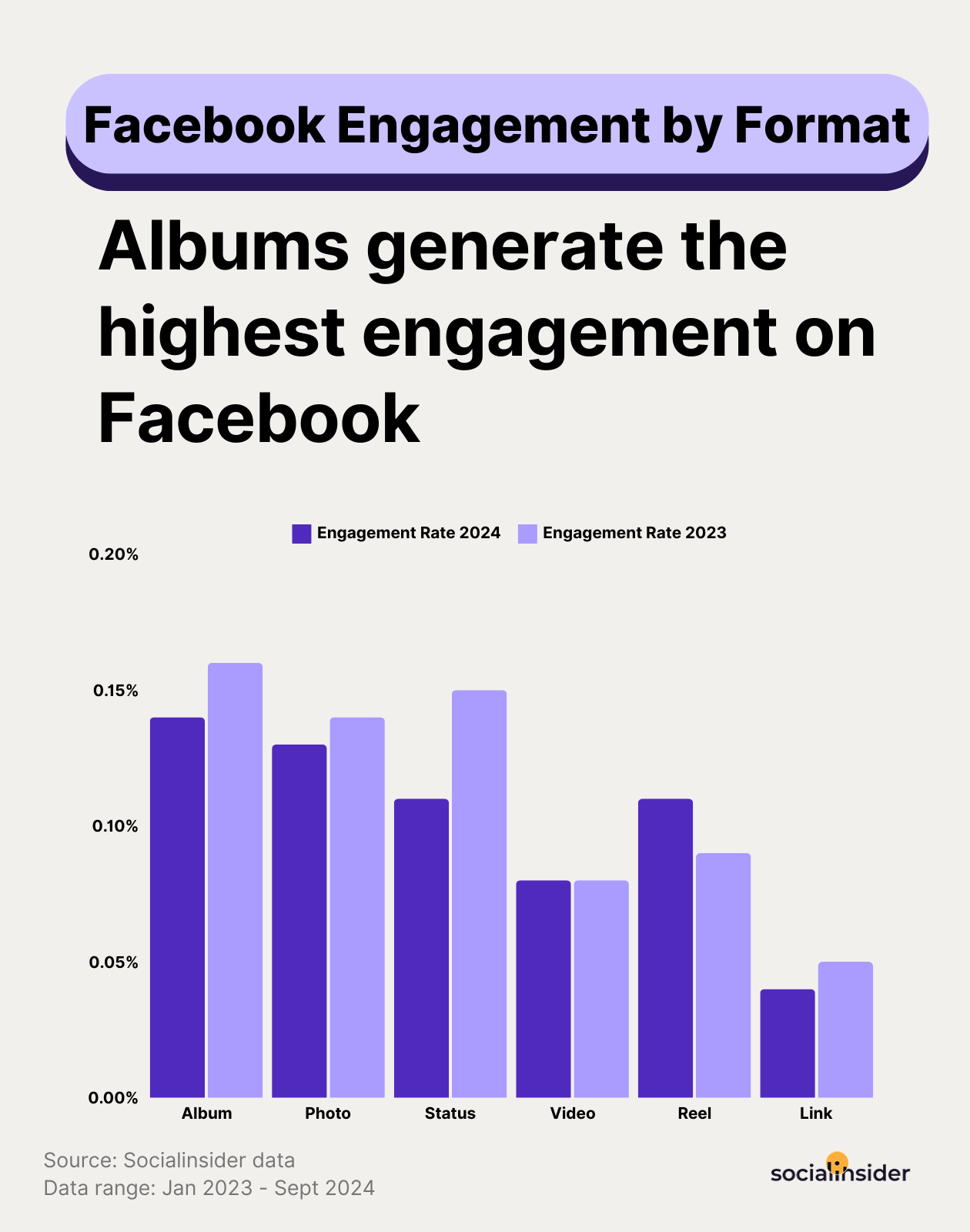
Step 6: Audit the current content
While having an idea about what type of content is best to be leveraged for each platform based on the current trends, it's also important to dive into your own analytics and get social media optimization insights based on what your specific audience seems to like.
When planning content for social media marketing, it's also important to keep in mind your strategy's objectives.
For example, our Instagram benchmarks study revealed that Instagram carousels generate the highest engagement. So, for this particular purpose, this should be the content type with the heaviest usage in your Instagram posting calendar.
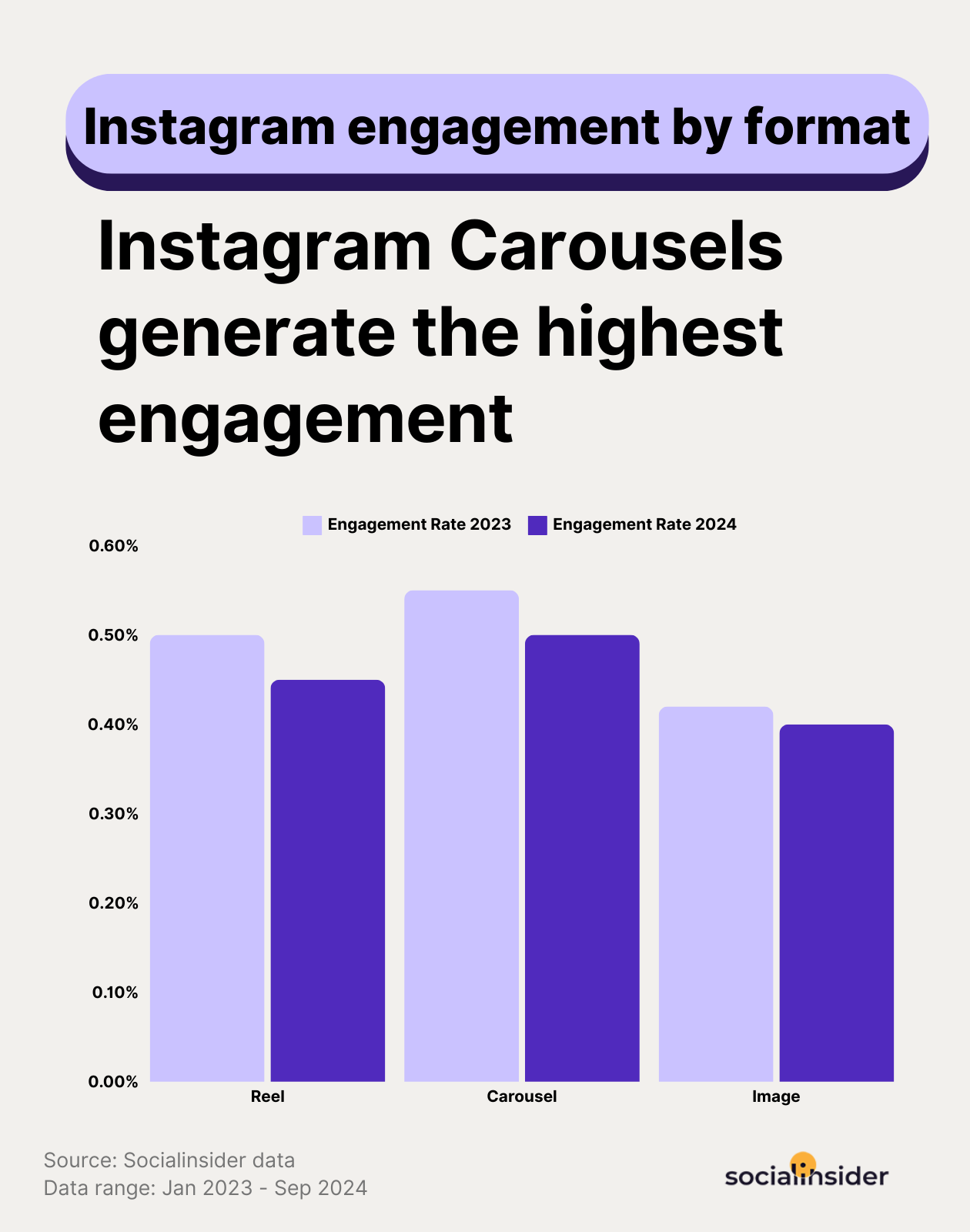
However, if your goal for Instagram marketing is to increase your reach, you may have noticed that Instagram Reels perform better, in which case, this post format should be used with priority.
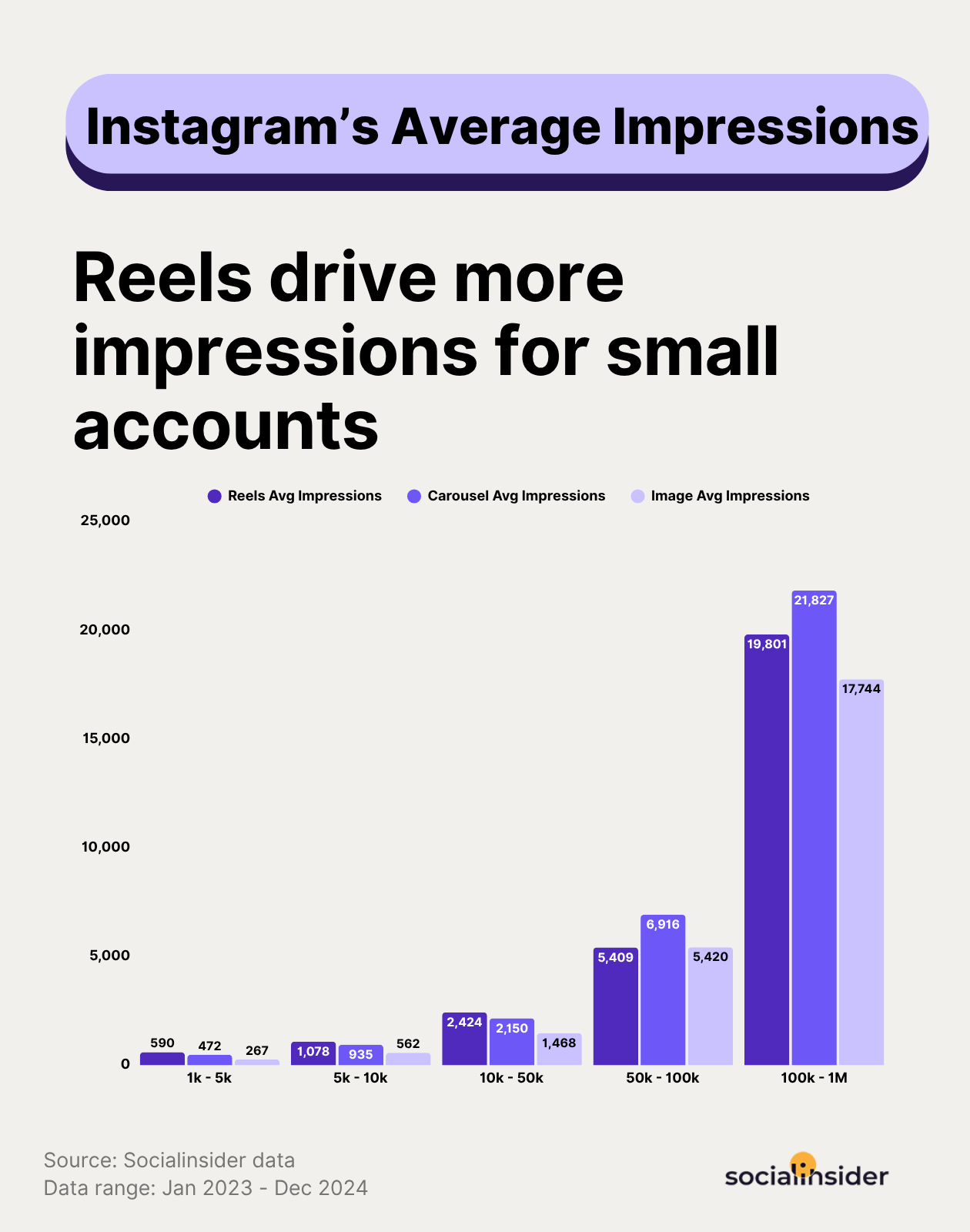
Ultimately, it all comes down to what you're trying to achieve on each platform. Base your content plan on what your social media analytics insights reveal, and you'll be one step closer to achieving your objectives.
Step 7: Decide on content pillars
Social media content pillars are the foundation of your social media strategy, representing the core topics your brand consistently posts about. These themes should reflect your brand's identity, address audience needs, and drive meaningful engagement.
Use Socialinsider to dive into what makes your audience tick. The platform gives you data-driven insights into what themes spark the most engagement.
For example, Lamborghini found that posts featuring Industry News & Trends racked up almost 4.3 million engagements from 19 posts—talk about hitting the sweet spot. Meanwhile, Vehicle Showcases & Reviews drove over 1.3 million interactions from just 8 posts, hinting at an untapped growth opportunity.
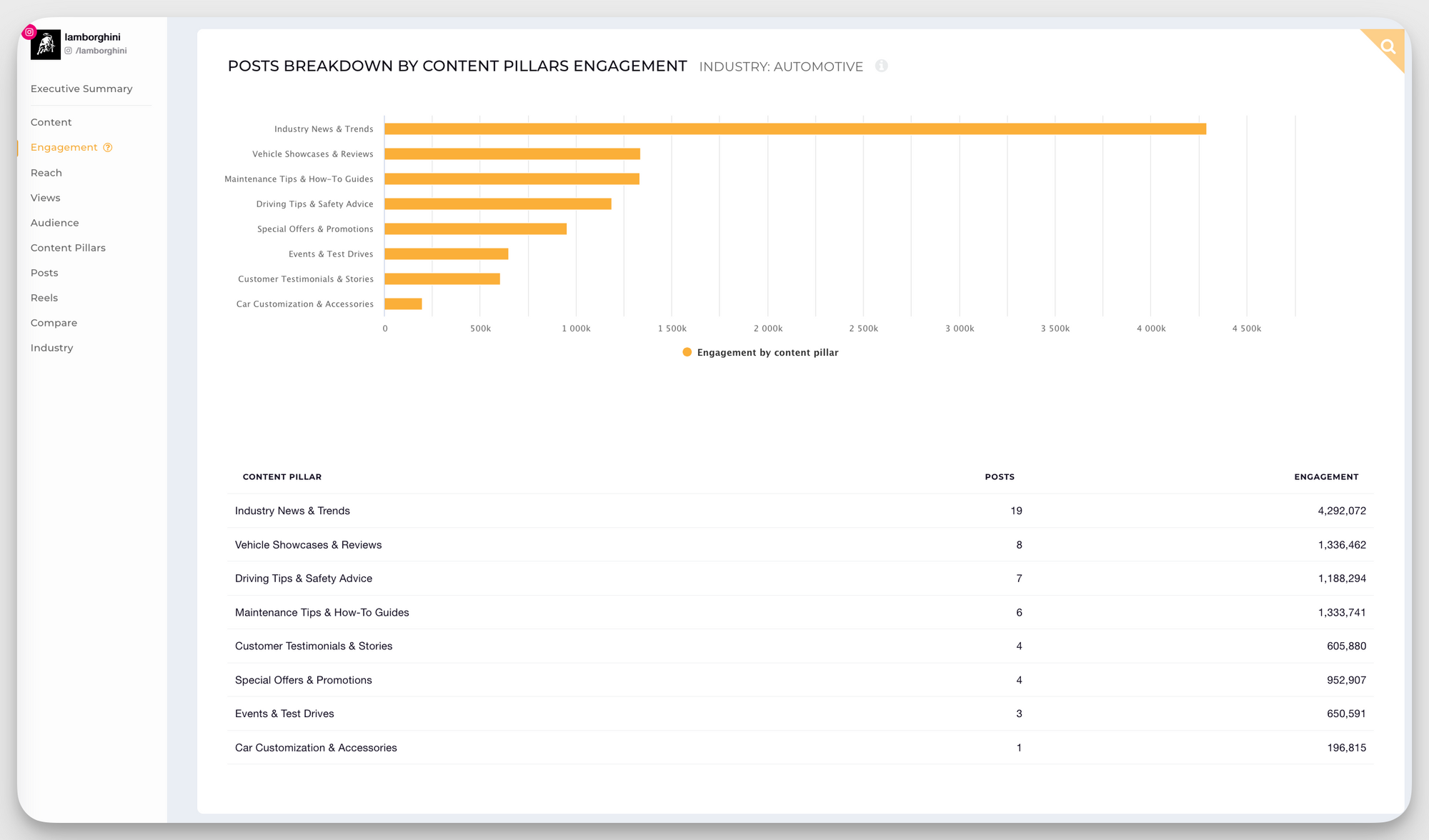
These insights help identify not only the most engaging themes but also areas where your content strategy could expand.
Benchmarking against competitors adds even more depth. Socialinsider lets you compare your performance with others in your niche, giving you both inspiration and a roadmap to stand out.
Take Lamborghini, for instance—they nail it with Industry News & Trends. Even though they post considerably fewer posts in this category (19 vs. 32), they have a better engagement rate than their competitor Porsche, which suggests the format, tone of voice, or something else better resonates with the audience. This insight requires a deeper dive into what Lamborghini does differently to get these results, but this is exactly the kind of intel you need to fill gaps in your strategy and diversify your content mix effectively.

Beyond identifying successful pillars, Socialinsider also helps you maintain a balanced approach. It evaluates your content mix to ensure you're not over-relying on one theme while neglecting others.
By analyzing your current content mix, you can refine your approach to focus on what works while keeping your brand’s mission front and center.
This kind of data-backed strategy helps you stay authentic while creating content that connects with your audience and meets your goals.
With Socialinsider, you can keep refining your strategy, ensuring your content pillars strike the perfect balance between performance and staying true to your brand.
Step 8: Create a content calendar
A content calendar focuses on planning social media content—the what, where, and when you'll post—to keep your strategy sharp and consistent. From platforms (Instagram, TikTok, LinkedIn) to formats (video, carousel, image) to captions, it's all mapped out in one place.
Planning ahead means no more scrambling for ideas at the last minute. Instead, you'll have posts ready to roll, perfectly timed to align with social media campaigns, events, or seasonal trends.
Bonus: you'll save time, reduce stress, and maximize engagement while ensuring strategic planning for social media that makes every post count.
Steps to build a content calendar
Define your posting schedule
Decide how often you'll post on each platform based on audience preferences and your resources. For instance:
- Instagram: 3–5 posts weekly, including 1 Reel and 2 per day Stories.
- LinkedIn: 2–3 thoughtful posts weekly.
- TikTok: 1-2 trend-focused short videos weekly.
Plan content themes and formats
Assign themes to specific days to keep your content varied and engaging.
For example:
- Mondays: Behind-the-scenes insights.
- Wednesdays: Product highlights or tutorials.
- Fridays: User-generated content or customer stories.
Fill in the calendar
Include these key details for each post:
- Date/Time: E.g., January 15, 2:00 PM.
- Platform: Instagram, Facebook, LinkedIn, TikTok.
- Content format: Video, carousel, image.
- Captions: Include hashtags, mentions, and calls to action (CTAs).
- Post goal: Track which posts align with specific goals, such as engagement or traffic.
Here's a short example
Stay flexible
Leave room in your calendar for spontaneous posts, whether it's a trending topic, breaking news, or a behind-the-scenes update. Real-time content keeps your social media fresh and relevant.
Best practices for content calendars
- Batch-create content: Knock out multiple posts in one session for consistency and efficiency.
- Incorporate visuals: Add links to design files or videos directly in your calendar for seamless collaboration and review.
- Analyze and optimize: Track which posts resonate with your audience. Use these insights to double down on what works and ditch what doesn't
- Leave wiggle room: Your calendar should guide you, not box you in. Be ready to adjust for unexpected opportunities or trends.
Step 9: Publish content
Publishing is where all the social media content planning and creativity behind your social media content strategy come to life. It's about more than just hitting "post."
You also need to perfect social media content distribution—timing, format, and platform choice are critical for making your content resonate.
Here's how you can approach publishing:
Manual posting
It's perfect for real-time updates or capitalizing on trending moments. For example, if you're running a pop-up event or reacting to breaking news, posting manually lets you tailor your content on the spot (control) and stay relevant in the moment (immediacy).
Using scheduling tools
Scheduling tools like CoSchedule or Plable are lifesavers for streamlining your social media posting plan. You can set posts to go live during peak engagement hours when your audience is most active. Plus, these tools ensure a consistent posting rhythm and save you the hassle of juggling multiple platforms.
Step 10: Encourage conversations and community management
Social media is a two-way street, and consistent interaction helps build trust and loyalty. The more you engage, the more trust and loyalty you'll foster.
Share UGC
Think of user-generated content as the ultimate social proof. It's authentic and relatable and shows your brand in action through the eyes of real customers.
Respond promptly to comments, messages, and mentions
Timely responses show your audience you value their input.
Here's how to nail it:
- Reply to comments with genuine enthusiasm or helpful insights.
- Answer direct messages and customer inquiries within 24 hours.
- Acknowledge and thank users who tag or mention your brand.
Encourage meaningful conversations
Encourage discussion by asking questions in your captions, running polls on Instagram Stories, or hosting live Q&A sessions on Facebook or TikTok. These tactics humanize your brand while giving your audience a reason to stick around and participate.
Step 11: Invest in paid promotion
Paid promotion is like giving your best-performing content a megaphone to reach the right people faster.
When done right, paid strategies can supercharge social media traffic, spark engagement, and drive conversions, working hand-in-hand with your overall content strategy for social media.
Boosted posts
Boosting allows you to extend the life and reach of your top-performing organic posts. Let's say an Instagram Carousel hits it out of the park with likes and shares—why stop there? Boosting it can attract a wider audience and give your content the attention it deserves.
Video ads
Video ads are highly effective across platforms like TikTok, Instagram, and Facebook. Create short, engaging videos that showcase your product or service in action. Focus on storytelling and highlight key benefits in the first few seconds to grab attention.
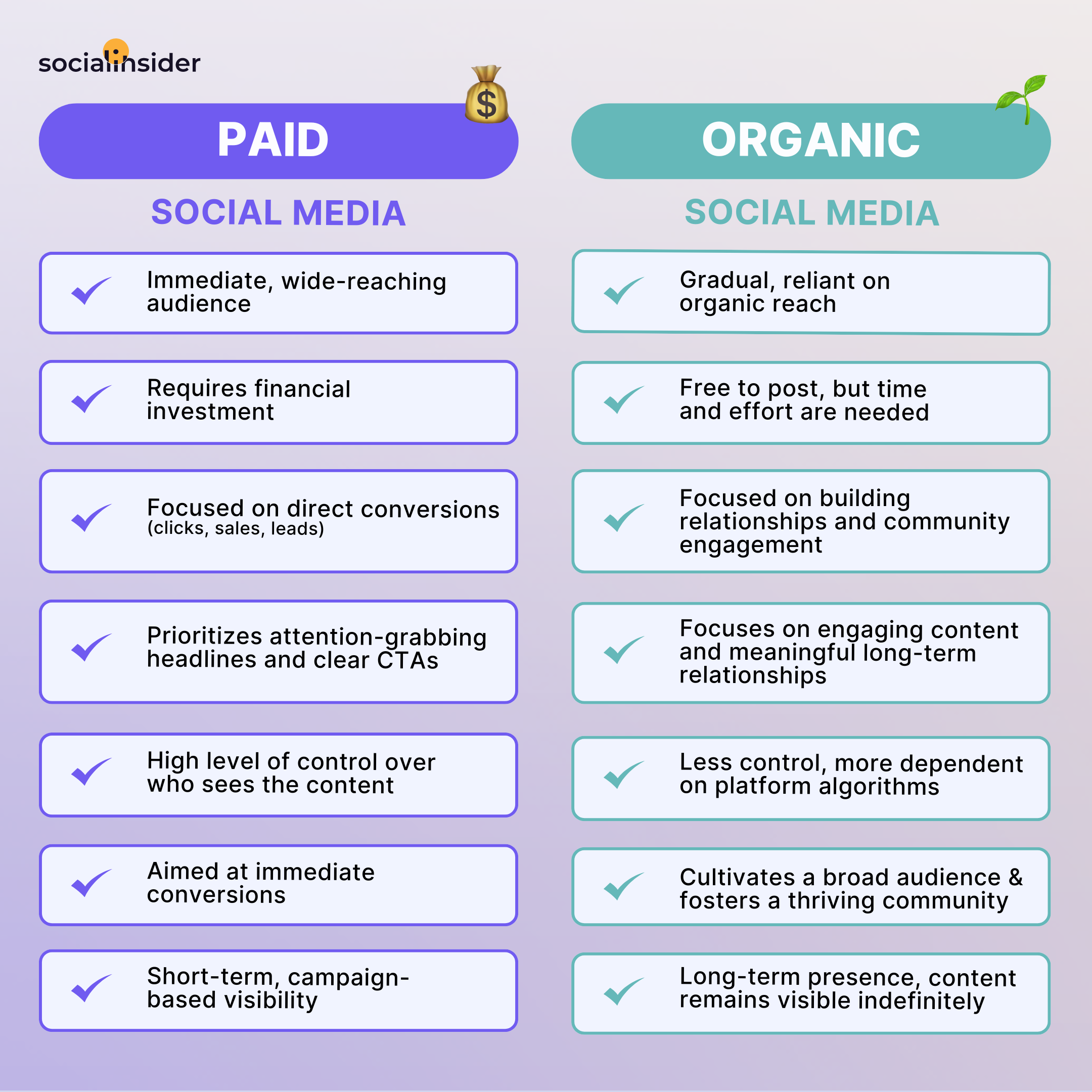
Influencer partnerships
Influencer marketing gives you access to something money can't buy: trust. Their audience already sees them as credible, so collaborating with them can be a direct route to your ideal customer. Just be strategic—pick influencers who genuinely align with your brand values and speak to your target demographic.
Step 12: Measure results
The last piece of your social media content strategy puzzle is social media measurement and refining your approach based on data. It's where all your planning and creativity come full circle.
Tracking the right metrics not only tells you how well your content aligns with the goals you set but also guides you in making smarter decisions to enhance your outcomes.
Socialinsider takes the guesswork out of planning content for social media and optimization, offering detailed insights into your content's performance and audience behavior.
Let's study this screenshot from the platform, for example:
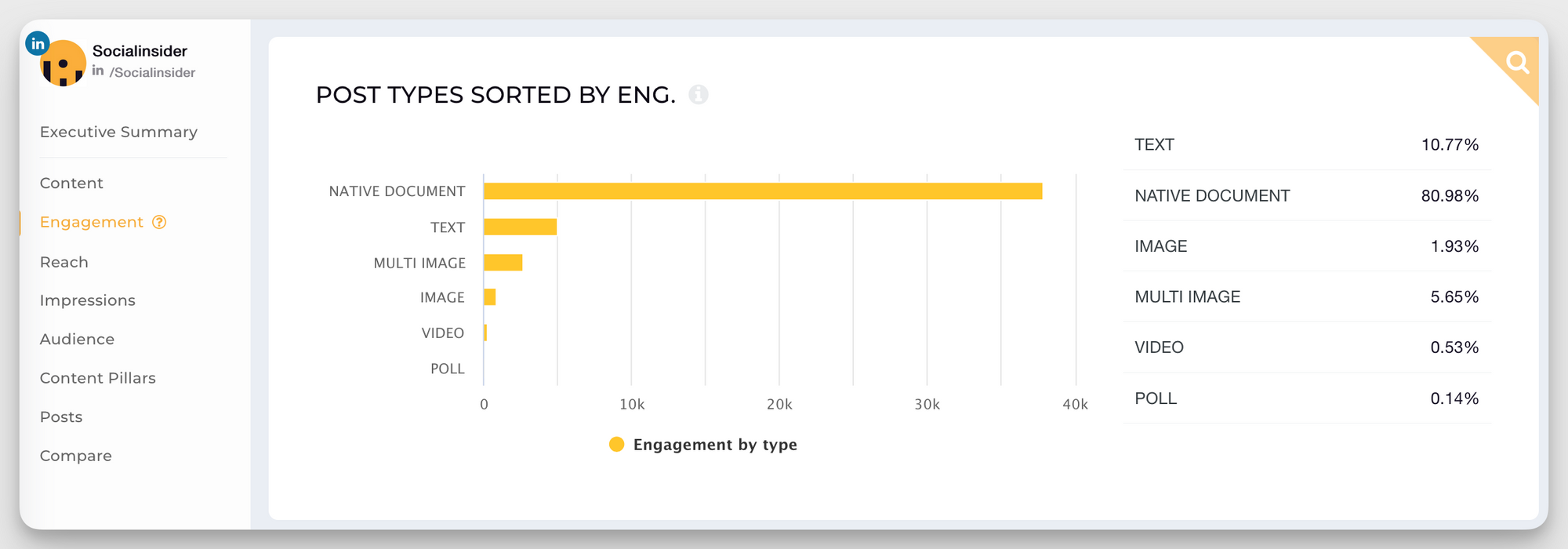
You can quickly see how different post types—like native documents, text posts, multi-image posts, and videos—are performing.
For instance, if native document posts consistently pull in the highest engagement, followed by text posts, you'll know exactly what's clicking with your audience.
That means you can double down on the more effective content creation strategies while giving less effective formats, like polls or videos, a thoughtful test run.
Tracking these metrics helps you spot trends and tweak your strategy on the fly. Maybe your text posts are thriving, but you're ready to mix things up.
With Socialinsider, you can try out new formats and see how they stack up. If something new resonates, you can fold it into your content pillars, keeping your strategy both flexible and data-driven.
The result? A streamlined content plan laser-focused on delivering real results.
Final thoughts
Building content strategies for social media is about more than just posting—it's about being intentional. You're setting SMART goals, understanding your audience, focusing on the right platforms, using data to drive your decisions… basically, a lot of things.
Yes, it takes effort, but the payoff is worth it. A well-thought-out strategy not only amplifies your reach but fosters meaningful connections with your audience.
Plus, with Socialinsider, content marketing for social media becomes much more manageable. You'll gain clear, actionable insights into what's resonating with your audience and what's falling flat, so you can fine-tune your strategy confidently.
Take the first step to ensure effective social media content strategies: analyze your content, refine your strategy, and watch your results improve. Also, check out our social media campaign template to ensure a seamless campaign execution.
FAQs about social media content strategy
1. What are the 7 C's of social media strategy?
The 7 C's of social media strategy provide a comprehensive framework for developing an effective social media presence:
- Content: Creating valuable, relevant material that resonates with your audience and supports your business goals. This includes a mix of formats (videos, images, text) and types (educational, entertaining, promotional).
- Community: Building and nurturing relationships with your followers by creating a sense of belonging, recognizing community members, and facilitating connections between followers.
- Conversation: Engaging in meaningful two-way communication rather than simply broadcasting messages. This includes responding to comments, asking questions, and participating in relevant discussions.
- Consistency: Maintaining a regular posting schedule, coherent brand voice, and visual identity across all channels to build recognition and trust.
- Collaboration: Partnering with influencers, customers, and complementary brands to extend reach, add credibility, and provide fresh perspectives through co-created content.
- Conversion: Turning social media engagement into measurable business results through strategic calls-to-action, optimized sales funnels, and effective attribution tracking.
- Curation: Thoughtfully selecting and sharing content from various sources to complement your original content, position your brand as an industry resource, and maintain a consistent posting cadence.
By addressing all seven elements in your strategy, you'll create a balanced, effective social media presence that drives real business results.
2. What is the 5/5/5 rule on social media?
The 5/5/5 rule is a content diversification framework that helps maintain audience interest and maximize engagement by ensuring variety in your social media content mix:
- 5 different content formats: Incorporate diverse media types such as videos, images, carousels, text posts, polls, live streams, stories, or reels. This variety caters to different consumption preferences and keeps your feed visually interesting.
- 5 different content types: Balance your content purposes, including educational (how-tos, tips), entertaining (humor, behind-the-scenes), inspirational (quotes, success stories), promotional (product features, offers), and conversational (questions, community highlights).
- 5 different content pillars: Organize your content around five key themes or topics that align with both your brand identity and audience interests. These pillars create consistency while allowing for creative exploration within defined boundaries.
Following the 5/5/5 rule prevents content fatigue, helps you reach different segments of your audience, and provides a structured approach to content planning while maintaining flexibility and creativity.
3. What is the 50/30/20 rule for social media?
The 50/30/20 rule is a resource allocation framework for social media that helps brands prioritize their efforts across different platforms:
- 50% of resources to your primary platform: Dedicate half of your social media budget, time, and creative efforts to the platform where your target audience is most active and engaged. This is typically where you'll see the highest return on investment.
- 30% of resources to your secondary platform: Allocate about a third of your resources to a second platform that either reaches a different audience segment or serves a complementary purpose to your primary platform (e.g., awareness vs. conversion).
- 20% of resources to experimental platforms: Reserve the remaining resources for testing emerging platforms, exploring new features, or maintaining a minimal presence on less strategic channels. This allows for innovation while minimizing risk.
This rule ensures you maintain focus on platforms with proven ROI while still exploring new opportunities and adapting to the evolving social media landscape. The exact percentages can be adjusted based on your specific business goals, audience behavior, and available resources.
Analyze your competitors in seconds
Track & analyze your competitors and get top social media metrics and more!
You might also like
Improve your social media strategy with Socialinsider!
Use in-depth data to measure your social accounts’ performance, analyze competitors, and gain insights to improve your strategy.

